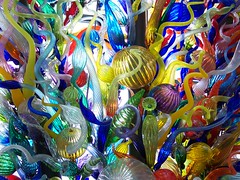I have been thinking about our role as librarians, as well as ways to market library services to a sometimes less-than-excited public. I think I have a draft of an analogy that might fit our circumstances, and help get across to our many audiences how important it is to keep connected to information and those that know where it lives.
A suspension bridge has been built, joining two geographic areas in a new-fashioned way, or as the first time either side has been joined to the other. News crews appear, interviewing the construction project manager, the steelworkers, the painters, the concrete workers, the architects, the funders. A crowd appears, expressing awe at the expanse gleaming in the sun. Numbers might get tossed around - the many square yards of concrete, the many miles of cable, the distance of the bridge above the ground, how long it took to plan and build the bridge. There might be a ceremony, attended by dignitaries, marking the bridge open and serving the public. Everyone acknowledges how great the bridge is and how it will impact mankind. But rarely does anyone interview the cable supplier or manufacturer. No reporter asks what types of cable were considered, how the cables were made of individual strands of wire, which cable type was selected and why, how the cable got to the worksite (well, maybe that last one might be newsworthy). Usually, there is talk about how many pounds of force the number of cables must be able to support, and sometimes the topic of cable comes up in discussion if there was any trouble acquiring it or if the cost was extraordinary. Otherwise, discussion about the intricacies of cable takes place at cable suppliers' association meetings, on the floor of cable manufacturing factories, and among engineers that design new versions of cable. Those involved with cable know that the number of suspension bridges might be reduced in the future in favor of new bridge styles, but they have responsibility to keep renewing the cables on existing bridges, as well as identify new uses and forms of cable to support emerging markets.
Information and its delivery is the cable of "suspension bridge" research projects that join mankind to new ways of living. Research results make big news, but rarely discuss in press releases or documentaries where information (or lack of access to information, or information providers, or librarians) played a role in the outcomes. Research would suffer and projects could not be built strong without information being a key support to the discoveries. While I personally think libraries, librarians, and information providers should be showcased every day on the 6 0'clock news for the vital role they play in the world, I don't mind playing the role of cable supplier in the scheme of things. Every once in a while, though, I would like to see a few documentaries covering ground-breaking research add discussion on the role that information played in leading to the results. It would be great if librarians and vendors would get together to do such a series, if only to educate the public that appear to think running a simple search through the internet constitutes research. Maybe this would work to reduce the comments of, "oh, you don't need to have funds to support a library; information is free and easy to get for everyone on the Internet." Librarians [and vendors] could start buying 'congratulations' ads in the newspaper whenever a research project hits the news, like the concrete company and architect's office does when a new bridge is built, just to remind everyone what our role is in the finished product.
Thank you for reading this, and please let me know if this analogy can be improved, changed, or if you want to challenge it. -Teri
Monday, January 17, 2005
Subscribe to:
Post Comments (Atom)


No comments:
Post a Comment